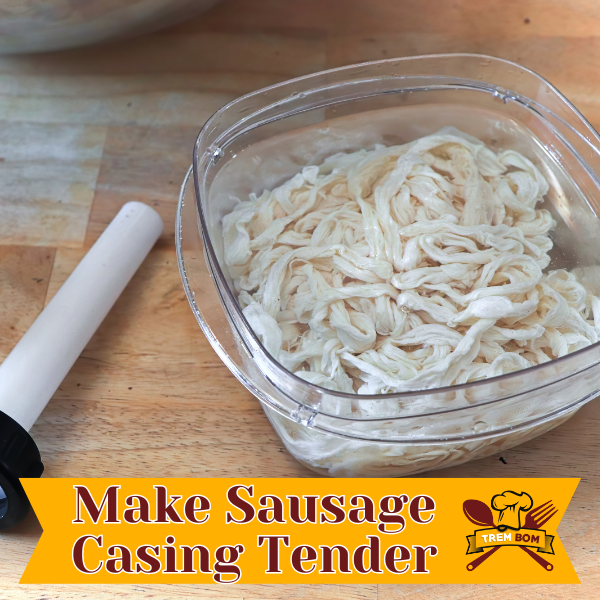
Making homemade sausages can be a fun and rewarding experience. However, achieving tender sausage casings can be a challenge for many. In this article, we will share with you the secrets to making tender sausage casings every time, ensuring that your homemade sausages are juicy and delicious.
Key Takeaways:
- Learning how to make sausage casing tender is essential for juicy and enjoyable homemade sausages.
- Choosing the right casing, preparing the casings properly, and applying moisture to the casings are crucial in achieving tender results.
- The cooking process and resting the sausages after cooking also have significant impacts on the tenderness of the casing.
- Ingredients such as acid, salt, and enzymes can help tenderize the sausage casings.
- Properly storing sausages after making them is essential to maintain the tenderness of the casing.
Understanding Sausage Casing
When it comes to making sausages, the casing plays a crucial role in determining its texture and flavor. Understanding the different types of sausage casings available and their characteristics is essential to achieve the desired results. Here is an overview of the most common sausage casing options:
| Type of Casing | Characteristics |
|---|---|
| Natural Casings | Typically made from the intestines of animals, natural casings can range in size and thickness, and are known for their tender texture. |
| Collagen Casings | Made from edible collagen, these casings are uniform in size and shape, and have a more durable texture compared to natural casings. |
| Fibrous Casings | Typically used for larger sausages, fibrous casings are made from cellulose and have a paper-like texture. |
| Synthetic Casings | These casings are made from plastic and provide a consistent size and shape, and are suitable for high-volume production. |
Choosing the right casing is crucial for ensuring tender sausages. Natural casings are typically the best option for achieving tenderness, but collagen casings can also produce good results. Understanding the characteristics of each casing will help you make the appropriate choice for your sausages.
Choosing the Right Casing for Tender Sausages
When it comes to achieving tender sausages, selecting the appropriate casing is critical. The casing serves as a protective layer that holds in the juices while keeping the meat inside intact. The right casing choice can make all the difference in achieving perfect tenderness.
Types of Casing
There are several types of sausage casings to choose from, including natural and synthetic options. Natural casings, such as hog or sheep casings, are the traditional choice. These casings have a natural feel and help to create a classic sausage taste. However, they can be challenging to work with and require additional preparation.
Synthetic casings, on the other hand, come in a variety of shapes and sizes, including collagen, fibrous, and plastic casings. They are easy to use and require minimal preparation, making them a popular choice for home sausage makers.
Tips to Tenderize Casing
No matter which casing you choose, tenderizing the casing is crucial for attaining perfect tenderness. Here are some tips to tenderize the casing:
- Soaking: Soak the casing in warm water before use to soften it and make it more pliable. This step will also help to prevent the casing from breaking during stuffing.
- Adding Salt: Sprinkling salt on the casing can help to tenderize it. Salt breaks down the protein in the casing, making it more tender and pliable.
- Using Acid: Adding acid to the sausage mix can help to tenderize the casing. Acidic ingredients, such as vinegar or citrus juice, will break down the protein in the casing and make it more tender.
By choosing the right casing and following these tips to tenderize it, you’ll be well on your way to achieving perfectly tender sausages.
Preparing Sausage Casings
Before stuffing your sausage, preparing the casing is essential to ensure tenderness. Here are some methods to soften sausage casings:
- Soaking in warm water for 20-30 minutes before use
- Adding vinegar to the water to aid in the softening process
- Using a mixture of salt and warm water to rub down the casings
Pro-tip: Don’t skip this step! Properly preparing your sausage casings will make them more pliable and easier to work with, ultimately resulting in tender and juicy sausages.
After softening the casings, rinse them thoroughly under cold water and check for any tears or holes. If there are any imperfections, discard the casing and start with a new one.
Now that your sausage casings are soft and ready to use, it’s time to move on to the next step for achieving tender sausages: stuffing the casings gently. Let’s take a look at how to do this in the next section.
Stuffing the Casings Gently
When it comes to tenderizing sausage casings, how you stuff the sausages matters. Overstuffing can cause the casings to burst, while insufficient stuffing can result in loose, tough casings. To ensure the perfect balance, we recommend using a sausage stuffer and following these tips:
- Fill the stuffer slowly and evenly, without pushing or forcing the meat into the casings.
- Avoid air pockets by gently pressing the meat down into the casings with your fingers or a sausage pricker.
- Leave a bit of slack in the casings to prevent excessive tension and help the sausages cook evenly.
By stuffing the casings gently, you can prevent tearing and ensure that the casings remain tender and juicy.
Applying Moisture to the Casings
Moisture is critical for achieving tender and juicy sausage casings. To make your sausage casing tender, you can try different methods of applying moisture to the casings. Here are the techniques that we have found to be effective:
Method 1: Soaking the Casings
Soaking sausage casings in warm water will help to soften them and make them more pliable. It is best to use clean water and soak them for about 30 minutes.
Method 2: Using Oil or Fat
Using oil or fat such as butter or olive oil is another way to make your sausage casings tender. You can add a little bit of oil or fat to the meat mixture and incorporate it before stuffing the casings.
Method 3: Spraying Water or Vinegar
You can also use a spray bottle to apply a mist of water or vinegar to the casings. The moisture will help to prevent them from drying out and make them tender.
Method 4: Steaming the Sausages
Steaming the sausages after cooking is another technique to ensure tender sausage casings. Simply place the cooked sausages in a steamer basket and steam for a few minutes. This will add moisture to the casing and ensure tenderness.
Experiment with these methods to discover what works best for you. With these simple techniques, you can achieve perfectly tender sausage casings for your homemade sausages.
Cooking Sausages at the Right Temperature
Now that we’ve discussed how to choose the right casing and prepare it for stuffing, it’s time to move on to the cooking process. Cooking sausages at the right temperature is crucial for achieving tender, juicy results.
The ideal cooking temperature for sausages is 160°F (71°C). It’s important to use a meat thermometer to ensure that the internal temperature of the sausage reaches this level. Cooking sausages at too high a temperature can cause the casing to become tough and chewy.
When cooking sausages, it’s best to use gentle heat, such as on a grill or in a pan on low-medium heat. This slower cooking method allows the sausage to cook evenly and prevents the casing from bursting and losing its juices.
Remember to turn the sausages frequently to ensure even cooking. Once the sausages have reached the ideal temperature, remove them from the heat and allow them to rest for a few minutes to allow the juices to distribute evenly for the most flavorsome results.
By cooking sausages at the right temperature and taking care to avoid high heat, you can achieve tender, juicy sausages with perfectly cooked casings.
Resting the Sausages
After cooking sausages, it’s important to allow them to rest before slicing or serving. Resting the sausages is crucial to maintaining their tenderness, particularly their casing. As the sausages rest, the juices redistribute throughout the meat, ensuring that each bite is succulent and tender.
During the cooking process, the heat causes the meat fibers and sausage casings to expand. Without resting, these fibers and casings remain taut, making the sausages tougher. Resting allows the fibers and casings to contract, resulting in a more relaxed, tender texture.
How long you should rest the sausages depends on their size. For smaller sausages, like breakfast links, five minutes should suffice. Larger sausages may require up to 15 minutes of resting time. Be sure to cover the sausages with foil or a lid while they rest to prevent them from cooling too quickly.
Resting the sausages is the final step in achieving tender sausage casings. By taking the time to rest your sausages, you’ll enjoy juicy, flavorful bites that will keep you coming back for more.
The Role of Ingredients in Tenderizing Casings
When it comes to tenderizing sausage casings, certain ingredients can be incredibly helpful. Incorporating acid, salt, and enzymes into your sausage-making process can help achieve tender results.
Acid in the form of vinegar, lemon juice, or buttermilk can help break down the tough proteins in the casing, making them more pliable and tender. However, be careful not to add too much acid, as it can also cause the casings to become brittle and disintegrate.
Salt, on the other hand, helps to hydrate the casings and improve their texture. Adding salt also enhances the flavor of the sausages and can help to prevent spoilage.
Enzymes such as papain or bromelain found in pineapple or papaya can help break down the proteins in the casing, resulting in a more tender texture. You can add these ingredients to the sausage mixture or use them as a marinade to impart their tenderizing benefits.
Experiment with different amounts and combinations of these ingredients to find what works best for you and your recipe. With the right ingredients and techniques, you can achieve perfectly tender sausage casings that will take your homemade sausages to the next level.
Troubleshooting Tender Sausage Casing
Despite our best efforts, sausage casings may not always turn out as tender as we’d like. This can be frustrating, but there are some common issues and solutions to help troubleshoot the problem.
Inconsistent Texture in Sausage Casings
If the texture of the sausage casings is inconsistent, it could be due to uneven stuffing. This can be caused by using too much or too little meat or not properly packing the meat into the casing. To remedy this, try adjusting the amount of meat and the packing technique to achieve consistent texture throughout.
Tough Sausage Casings
If the sausage casings turn out tough, it could be due to over-stuffing, which could cause the casing to burst during the cooking process. The best way to avoid this issue is to gently stuff the casings and leave some room for air to escape. Additionally, avoid piercing the casings during cooking, which can cause them to toughen up.
Cracked or Split Sausage Casings
If the sausage casings split or crack during the cooking process, it could be due to insufficient moisture. Make sure to adequately moisten the casings before stuffing, as dry casings can become brittle and crack. Also, avoid subjecting the sausages to sudden changes in temperature, which can cause the casing to split.
Inconsistent Cooking of Sausage Casings
If the sausage casings are inconsistently cooked, it may be due to variations in the size of the links. To remedy this, try to make sure the links are all the same size and shape before cooking. Additionally, keep the cooking temperature consistent to ensure even cooking throughout.
By following these troubleshooting tips, we should be able to achieve tender and delicious sausage casings every time. With some practice and experimentation, we can perfect our sausage-making skills and wow our friends and family with homemade sausages that are sure to impress.
Tips for Storing Sausages with Tender Casings
After putting in the time and effort to achieve perfectly tender sausage casings, it’s important to store them properly to maintain their delicate texture. Here are some tips to keep your sausages juicy and tender:
- Cool them down first: Allow the sausages to cool to room temperature before storing them. Placing hot sausages in the fridge or freezer can cause moisture buildup, leading to mushy casings.
- Store in airtight containers: Use airtight containers or resealable plastic bags to prevent air from getting in and drying out the casings. This will also help prevent the sausages from absorbing unwanted odors from other foods in the fridge or freezer.
- Use wax paper or parchment paper: If stacking sausages, place a sheet of wax paper or parchment paper between each layer to prevent them from sticking together and tearing the casing.
- Use a vacuum sealer: For long-term storage, consider investing in a vacuum sealer to remove excess air and prevent freezer burn.
- Label and date: Be sure to label and date your sausages to avoid confusion and spoilage.
With these simple tips, you can enjoy your homemade sausages with tender, flavorful casings for longer periods. Happy cooking!
Conclusion
We hope this article has been helpful in revealing the secrets to achieving tender sausage casings for your homemade sausages. By understanding the different types of casings and selecting the appropriate one, properly preparing and stuffing the casings, applying moisture and cooking at the right temperature, and using certain ingredients, you can attain tender and juicy sausages every time.
Remember that troubleshooting may be necessary at times, but with persistence and practice, you can perfect the art of making tender sausages. Store your sausages properly to maintain their tenderness and enjoy the fruits of your labor with confidence.
As always, if you have any questions or comments, please don’t hesitate to reach out to our team. We’re here to help and support you on your journey to becoming a master sausage maker!
FAQ
How do I make sausage casing tender?
To make sausage casing tender, there are several techniques you can try. These include soaking the casings in water, marinating them in a vinegar solution, or using a meat tenderizer to soften the casing. Experiment with different methods to find what works best for you.
How can I tenderize sausage casing?
Tenderizing sausage casing can be achieved by gently massaging the casings to remove excess moisture and soften them. You can also try steaming the casings or using a needle tenderizer to puncture the casing and allow moisture to penetrate.
Are there any tips for softening sausage casings?
Yes, there are several tips for softening sausage casings. One method is to soak the casings in warm water for about 30 minutes before using them. Another tip is to add a small amount of salt or baking soda to the water, as this can help soften the casings. Additionally, you can try rolling the casings gently between your hands to make them more pliable.
What are some tenderizing techniques for sausage casing?
Some tenderizing techniques for sausage casing include pre-soaking the casings in warm water, using a vinegar solution to marinate the casings, or using a meat tenderizer to break down the proteins in the casing. These techniques help to soften the casings and make them more tender.
How do I choose the right casing for tender sausages?
Choosing the right casing is important for achieving tender sausages. Opt for natural casings, such as hog or sheep casings, as they tend to have a more tender texture. Artificial casings, such as collagen or cellulose casings, can also provide a tender result. Experiment with different casings to find the one that suits your preferences.
How can I apply moisture to the casings to make them tender?
There are different ways to apply moisture to sausage casings to make them tender. You can spritz the casings with water or a vinegar solution while they are cooking or use a basting brush to apply a thin layer of oil or marinade. This helps to prevent the casings from drying out and contributes to their tenderness.
What is the ideal cooking temperature for achieving tender sausage casings?
The ideal cooking temperature for tender sausage casings is around 160 to 165°F (71 to 74°C). This ensures the internal temperature of the sausage is fully cooked while maintaining the tenderness of the casing.
Why is resting the sausages important for tender casings?
Resting the sausages after cooking is crucial for allowing the juices to redistribute and the casings to soften further. This resting period, typically 10 to 15 minutes, helps to retain moisture and improves the overall texture of the sausage casings.
Can certain ingredients help tenderize sausage casings?
Absolutely! Acidic ingredients like vinegar, lemon juice, or wine can help tenderize sausage casings. Salt can also play a role in enhancing tenderness. Additionally, certain enzymes found in fresh fruits like pineapple or papaya can break down proteins and contribute to tender casings.
What should I do if my sausage casings are not as tender as I’d like?
If your sausage casings are not as tender as you would like, there are a few troubleshooting solutions you can try. You can try cooking the sausages at a slightly lower temperature or for a shorter time to prevent the casings from becoming tough. You can also adjust the techniques used for preparing and stuffing the casings. Experimentation and practice will help you achieve the desired tenderness.
Do you have any tips for storing sausages with tender casings?
For storing sausages with tender casings, it’s crucial to keep them in airtight containers or tightly sealed ziplock bags in the refrigerator. This helps to maintain their moisture and tenderness. If freezing the sausages, ensure they are well-wrapped to prevent freezer burn and maintain their quality.






